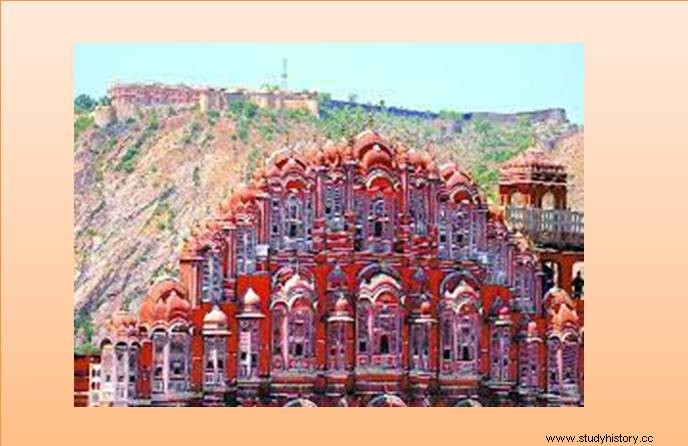
Sawai Jai Singh had a special love for architecture. He wanted to make his capital as grand, beautiful and convenient as the Mughal rulers. Initially he got some buildings built in Amer, but when he saw that there was not much scope for expansion in Amer, he decided to establish a new city for his capital. The plan to settle this city was much ahead of its time because during this period the drunken Marathas had started trampling North India and the invasions of the invaders coming from Afghanistan had not stopped yet. In such a situation, it was convenient for any king to keep his capital safe within the periphery of the fort. Nevertheless, Jai Singh decided to build such a city which was surrounded by thick ramparts and guard soldiers. Although Sawai Jai Singh laid the foundation stone of 'Jaipur' city in his name on 18 November 1727, however, in 1725 AD, the initial work for the establishment of Jaipur city had started. To prepare the city plan of Jaipur, a Bengali Brahmin, Vidyadhar Bhattacharya, was invited, who was a master of astrology, mathematics and Vastu Shastra. Maps of many cities were called from the country and abroad to prepare the map of Jaipur. The routes of the proposed city were kept of one size, one shape and one shape on the basis of geometrical formulas and motion. Each route was either exactly parallel to each other or intersected at right angles to each other. At these intersections, intersections were made, which were called Chaupar. At these intersections, fountains releasing water were installed. Lines of shops were formed on both sides of the roads and around the intersections.
With the help of Vidyadhar, Raja Jai Singh started setting up a city with square shaped straight roads and straight streets. Craftsmen were brought from different cities of India for the construction work to be done in this city. City gates named Suraj Pol in the east and Chandra Pol in the west were built. A two-mile long and straight road was built between these two city-gates. The width of this road was kept at 110 feet. This was determined to be the main road of Jaipur city. This road was cut at right angles from Ghat Gate (Shiv Pol) going from South to North at Ghora Nikal Road, Ramganj Chaupar. Similarly the road leading from Sanganeri Gate to Hawa Mahal market used to cut at right angles at Badi Chaupar. The road leading from Ajmeri Gate (Kishan Pol) towards Gangauri Bazar used to cross at Choti Chaupar. 'Jaynivas Mahal' was a wonderful creation of this city. It was the seventh part of the city built within the wall and looked like another city within the city. With the efforts of Sawai Jai Singh, his new capital Jaipur became a beautiful city of India. In 1728 AD, Jai Singh brought his capital from Amber to Jaipur, but it was duly announced in 1733 AD. After this, the capital of the Kachhwahas became Jaipur forever. Jai Singh mobilized 17 thousand soldiers on the defense of Jaipur. For about fifteen years, Jai Singh lived in this city splendidly. Various tourists and travelers have praised this city very much. Four years after Jaipur was created, Bishop Haber visited it. In his memoirs he wrote - 'The city's wall is like the Kremlin city of Moscow.'
Traders from prosperous cities of India were invited to come to Jaipur for the activities of commerce and trade. Similarly, scholars, astrologers, ritualists from cities like Kashi and Mathura etc. were invited to stay in Jaipur and were given accommodation for their stay. French traveler Victor Jacquemont visited this city in 1832 AD. He has written in his description that how jewelers, goldsmiths, confectioners, tailors, potters, cobblers and blacksmiths are engaged in their work in the market of Jaipur city. Grain merchants sit with a light lattice and stacked heaps of grains. When the king's ride arrives, the merchants remove their daggers. The architecture of this city is of excellent quality. There is only one Chandni Chowk in Delhi, but there are many similar chowks in Jaipur. Stones for buildings are available from the hills here. The main streets of the city are lined with rich people's buildings with aarish walls inside and pink plaster on the outside. There are no ruins, huts or kutcha houses on these roads. Whereas in the inner streets there are houses of ordinary citizens. There are no garbage dumps anywhere.
This city was built so grand, so convenient and with such a scientific method that after attaining independence, this city was made the capital of Rajasthan even though it was not located in the middle of Rajasthan. Even today, Jaipur is the only city in India which, despite being completely based on the Indian system, is at the forefront of modernity. Poet Bakhtram Sah has given a detailed description of the establishment of Jaipur city in his book Buddhi Vilas. The opening part of the book is as follows-
Kooram Sawai Jaisangh Bhup Siromani,
Sujas Pratap Jakou is a shadow in the world.
Karan Sau Dani Pandavan Sai Kryani Mahar,
Maani marjad mer ram sau suhaiyu hai.
Sohai Ambawati Ki Dakshine Disi Sanganeri,
Dou Vechi city is unique settlement.
Naam takou dharyou hai swai jaipur,
Maaun surni hi mili surpur saun rachiyo hai.
